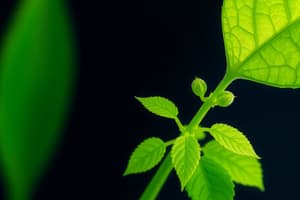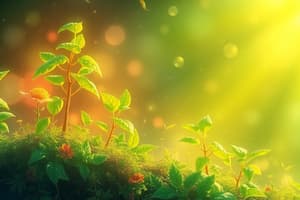Podcast
Questions and Answers
How many times must the Calvin cycle turn to produce one glucose molecule?
How many times must the Calvin cycle turn to produce one glucose molecule?
- 4 times
- 6 times (correct)
- 10 times
- 8 times
What is the main purpose of the adaptations like C4 and CAM pathways in some plants?
What is the main purpose of the adaptations like C4 and CAM pathways in some plants?
- To regulate temperature
- To minimize photorespiration (correct)
- To increase oxygen production
- To enhance water absorption
What is regenerated in the Calvin cycle to ensure its continuous operation?
What is regenerated in the Calvin cycle to ensure its continuous operation?
- Oxygen
- NADPH
- Glucose
- RuBP (correct)
Why is the Calvin cycle considered essential for life on Earth?
Why is the Calvin cycle considered essential for life on Earth?
What distinguishes the C4 pathway from the traditional Calvin cycle?
What distinguishes the C4 pathway from the traditional Calvin cycle?
What is the primary role of RuBisCo in the Calvin cycle?
What is the primary role of RuBisCo in the Calvin cycle?
Which molecule directly provides the electrons required for the conversion of 3PGA to G3P?
Which molecule directly provides the electrons required for the conversion of 3PGA to G3P?
What compound is formed when carbon dioxide is fixed in the Calvin cycle?
What compound is formed when carbon dioxide is fixed in the Calvin cycle?
What is one consequence of the photorespiration process facilitated by RuBisCo?
What is one consequence of the photorespiration process facilitated by RuBisCo?
Where does the Calvin cycle take place within plant cells?
Where does the Calvin cycle take place within plant cells?
Which type of molecules are primarily produced at the end of the Calvin cycle?
Which type of molecules are primarily produced at the end of the Calvin cycle?
Which energy currency is produced during the light-dependent reactions and used in the Calvin cycle?
Which energy currency is produced during the light-dependent reactions and used in the Calvin cycle?
In addition to carbon dioxide and energy, what other molecule is essential for the Calvin cycle?
In addition to carbon dioxide and energy, what other molecule is essential for the Calvin cycle?
Flashcards
Calvin Cycle
Calvin Cycle
The second stage of photosynthesis, converting carbon dioxide into glucose using ATP and NADPH.
Carbon Fixation
Carbon Fixation
The initial incorporation of carbon dioxide into an existing 5-carbon molecule (RuBP), catalyzed by RuBisCo.
RuBisCo
RuBisCo
The enzyme that catalyzes carbon fixation in the Calvin cycle.
G3P (glyceraldehyde-3-phosphate)
G3P (glyceraldehyde-3-phosphate)
Signup and view all the flashcards
ATP in Calvin Cycle
ATP in Calvin Cycle
Signup and view all the flashcards
NADPH in Calvin Cycle
NADPH in Calvin Cycle
Signup and view all the flashcards
Photorespiration
Photorespiration
Signup and view all the flashcards
Calvin Cycle Location
Calvin Cycle Location
Signup and view all the flashcards
Calvin Cycle's Role
Calvin Cycle's Role
Signup and view all the flashcards
6 turns for Glucose
6 turns for Glucose
Signup and view all the flashcards
RuBP Regeneration
RuBP Regeneration
Signup and view all the flashcards
C4 and CAM Pathways
C4 and CAM Pathways
Signup and view all the flashcards
Photorespiration Minimization
Photorespiration Minimization
Signup and view all the flashcards
Study Notes
Overview of the Calvin Cycle
- The Calvin cycle, also known as the light-independent reactions, is the second stage of photosynthesis
- It takes place in the stroma of chloroplasts
- The cycle uses ATP and NADPH (products of the light-dependent reactions) to convert carbon dioxide into glucose
- It is a cyclical process, meaning it does not produce a direct, final product after each turn, building gradually to a sugar.
Key Inputs
- Carbon dioxide: The source of carbon for glucose synthesis
- ATP: Provides the energy required for the reactions
- NADPH: Provides reducing power (electrons) for the reactions
Key Stages & Enzymes
- Carbon fixation (RuBisCo enzyme): Carbon dioxide is incorporated into an existing 5-carbon molecule (RuBP). This forms an unstable 6-carbon intermediate that quickly splits into two 3-carbon molecules (3PGA)
- Reduction: ATP and NADPH are used to convert 3PGA into G3P (glyceraldehyde-3-phosphate). G3P is a 3-carbon sugar. This is a crucial step as it requires adding energy from ATP and electrons from NADPH, converting energy-poor molecules to energy-rich.
- Regeneration: Some G3P molecules are used to produce glucose and other sugars. The majority of G3P molecules are used to regenerate RuBP, the 5-carbon acceptor molecule. This regeneration process requires further ATP. This is essential for maintaining the cycle.
Important Concepts
- This process turns inorganic carbon (CO2) into organic molecules that can be used by organisms for energy and building blocks.
- RuBisCo (ribulose-1,5-bisphosphate carboxylase/oxygenase) is the most abundant enzyme on Earth. It plays a critical role in carbon fixation. Its function, however, can also lead to photorespiration.
- Photorespiration is a process that occurs when RuBisCo adds oxygen instead of carbon dioxide to RuBP in some conditions, producing a 2-carbon molecule that is then broken down. This process is ultimately wasteful for the plant, decreasing the efficiency of photosynthesis.
- The Calvin cycle is crucial for life as it's the foundation of the food chain, enabling plants to produce sugars using sunlight, CO2, and water, which form a base for almost all other organisms to obtain energy. This process is fundamental for sustaining life on Earth.
Products of the Calvin Cycle (net gain)
- One molecule of G3P, a 3-carbon sugar.
- Additional G3Ps are combined to form more complex sugars such as glucose.
- To produce a single glucose molecule (a 6-carbon sugar), the cycle must turn 6 times.
- RuBP (the five-carbon sugar) gets regenerated, ensuring the continuous operation of the cycle to use CO2.
Variations and Adaptations
- Different plants have evolved adaptations to minimize photorespiration in different environments, such as C4 and CAM pathways of photosynthesis. These pathways separate the carbon fixation process from the Calvin cycle, or fix CO2 at night to conserve water, to more efficiently incorporate carbon. These alternative pathways illustrate the diversity and adaptation within life forms to suit their specific environments.
Significance
- The Calvin cycle is essential for the production of carbohydrates, providing the primary source of energy and organic building blocks for both plants and the ecosystems that depend on them. This highlights its critical function for sustaining life on Earth.
Studying That Suits You
Use AI to generate personalized quizzes and flashcards to suit your learning preferences.




